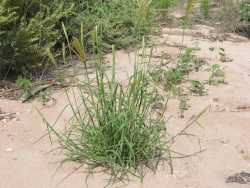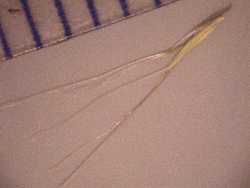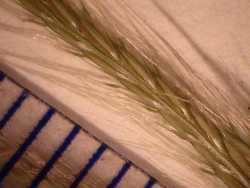Plants perennial; cespitose, sometimes stoloniferous. Culms to 100 cm. Sheaths glabrous or sparsely hirsute; ligules to 3 mm; blades to 20 cm long, 5-10 mm wide, scabrous. Panicles with 6-20 branches in several closely-spaced whorls, appearing as a single terminal cluster; branches to 15 cm, erect, with 7-9 spikelets per cm. Spikelets with 1 bisexual and 1(2) sterile floret(s). Lower glumes 0.8-1.1 mm; upper glumes 2-2.5 mm, awned, awns to 2 mm; lowest lemmas 2.4-3.8 mm long, about 0.5 mm wide, dorsally compressed, narrowly lanceolate to elliptic, scabrous, particularly distally, apices bilobed and 3-awned, central awns 8-12 mm, equaling or slightly longer than the 5-12 mm lateral awns; first sterile florets 1-1.5 mm, narrowing to 3 subequal 5-7 mm awns; second sterile florets, if present, similar but smaller. Caryopses 1.7-2.3 mm, strongly dorsally flattened. 2n = 40.
Trichloris crinita is a native species that grows in the southwestern United States and northern Mexico, and, as a disjunct, in northern Argentina.
Common Name: False Rhodes grass
Duration: Perennial
Nativity: Native
Lifeform: Graminoid
General: Densely tufted perennial, sometimes stoloniferous with stems to 100 cm.
Vegetative: Sheaths glabrous to sparsely hirsute, keeled and strongly compressed laterally below; ligule to 3 mm, ciliate; blades to 20 cm long, firm, flat, glaucous, 5-10 mm wide, coarsely hairy on upper surface near ligule.
Inflorescence: Appearing as a single cluster of long digitate spikes, the relatively narrow and dense panicle has 6-20 branches in closely spaced whorls; branches to 15 cm, erect, with 7-9 spikelets per cm; spikelets with single fertile floret and one occasionally two sterile florets; glumes unequal, one nerved, upper glumes 2 mm, with awns to 2 mm; fertile lemmas 2-4 mm, <1 mm wide, dorsally compressed, narrowly lanceolate to elliptic, scabrous, apices bilobed and 3-awned, central awns 8-12 mm, equaling or slightly longer than 5-12 mm lateral awns; lemma of first sterile floret 1 mm, narrowing to 3 subequal 5-7 mm awns, second similar but smaller.
Ecology: Found on dry flats, in canyons and on rocky slopes below 4,000 ft (1219 m); flowers May-September.
Distribution: AZ, s NM, s TX; south to s MEX.
Notes: Similar in appearance to Chloris, but with thinner inflorescence branches and appearing dense with long soft hairs, which are actually long awns due to the the 3-awned lemmas. Easily distinguished from the common and widespread annual Chloris virgata because T. crinita is perennial. Taxonomically, Trichloris is separated from Chloris on the basis of its 3-awned lemmas. This taxon is undergoing revision.
Ethnobotany: Unknown
Etymology: The tri- prefix of Trichloris refers to the 3 awned lemmas; Chloris is named for the Greek goddess of flowers; crinita means having long, soft hairs.
Synonyms: Chloris crinita, Chloris mendocina, Trichloris mendocina
Editor: SBuckley 2010, FSCoburn 2015, AHazelton 2015







